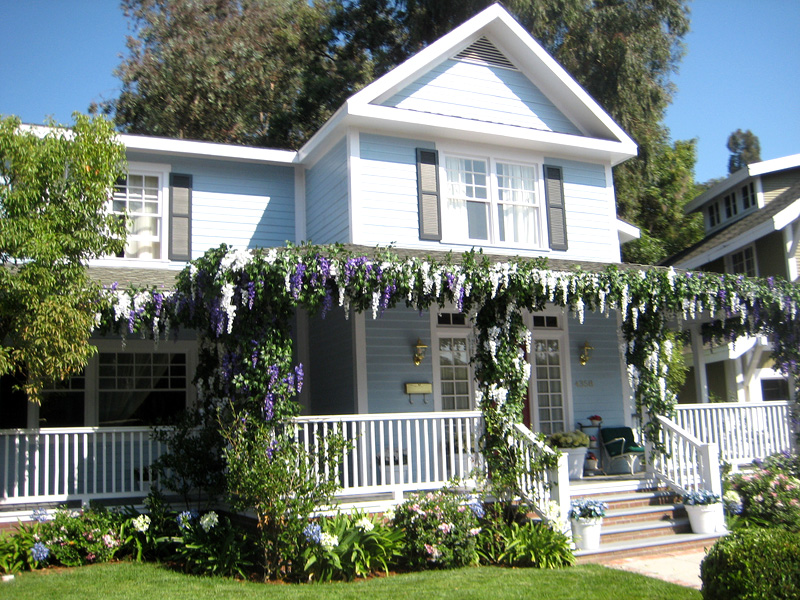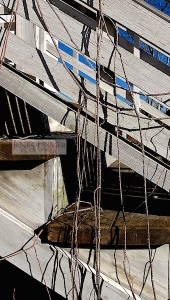Kill the Confederate Myths: 5 Better Vines for Southern Shade

Fake Wisteria on a TV set. Come on, wisteria and day lilies hardly ever flower at the same time.
When we started building Riverbanks Botanical Garden, 20+ years ago, we had to deal with a Pennsylvanian’s idea of southern architecture. The building, walls and walkways of some grandiose vision of antebellum structures that only ever existed in bad movies. It reminded me that, as a teen, I loved Aunti Mame as much as any other artsy young man. The scene of Mame at the cracker plantation in Georgia, (the plantation was called Peckerwood) with silk wisteria tacked up over 60 double stacked Doric columns was just too much. But maybe it helped me learn that, a) vines add ambiance, and b) they can cover up lots of mistakes.
It made me want to be a movie set designer so they’d get things right. I had no power to influence those choices. But at Riverbanks, I had a secret weapon and an intimate knowledge that would diminish the impact. I knew tons of great vines, and I knew how to take advantage of their individual proclivities and needs.
In a decision making process sort of like bad set design, I see people choose the wrong vine for their garden over and over. We couldn’t even begin to list here the hundreds, thousands of vining plants that thrive in the South. In fact, in our forest alone, we have some of the highest concentrations of vines in the world; second to a tropical forest. But here’s what I see way too much of: Confederate Jasmine that grows too much, and Clematis that needs more cold than we get, so don’t grow enough.
If you’re looking for a shade or privacy vine, here are my choices from several gardens I’ve designed recently. Not all are evergreen but remember, a dense build up of vines provides privacy in the winter, even when leaves fall. These are all big, woody vines (the specific word for that is liana). Some are available from the incredible Brushwood Nursery , a mail order nursery based in Georgia, that specializes in vines only. We’ll have some of these for sale at our Spring Crinum Farm open house. (To be invited to that you must be on our mailing list; click here)
- Cross Vine
Thumb sized trumpets in the spring literally cloak this vine. The secret to a big show is to plant this on an east facing space; the flowers are going to be on the sunny side. So don’t make the mistake of planting where the vine will do what vines do, scramble around till it finds the sun and flower on your neighbors side of the fence. I love the pastel forms such as ‘Athens’ and ‘Tangerine Beauty’, but there’s a ton of drama in the deep red ‘Dragon Lady’ or ‘Atrosanguina’ (Bignonia capreolata).
How it climbs: Needs a trellis to twine around, though will climb by tiny claw-like tendrils that do not enter or damage mortar.
- Grape Ivy
The coolest thing is that this vine drops long, string like adventious roots  from its main trunk making a magical, rain forest like web of dangling strings. Those amazing things will hang 15 feet or more. Waxy thick leaves show off small yellow flowers in July and bluish black fruit in August. Plant where you have no irrigation; this vine loves to bake in a parking lot and has been successfully grown as a green roof and living wall plant in the heat of Texas and Carolina. (Cissus trifoliate)
from its main trunk making a magical, rain forest like web of dangling strings. Those amazing things will hang 15 feet or more. Waxy thick leaves show off small yellow flowers in July and bluish black fruit in August. Plant where you have no irrigation; this vine loves to bake in a parking lot and has been successfully grown as a green roof and living wall plant in the heat of Texas and Carolina. (Cissus trifoliate)
How it climbs: Needs a trellis to twine around, though it will climb by adhesive pads that do not enter or damage mortar.
- WoodVamp
I have to grow this one just for the name. If you moved here from the north and want to mimic climbing hydrangea (which doesn’t grow well in the South

Woodvamp clings to the wall ignoring this expensive trellising system; making the architectural feature seem ridiculous and wasteful. (They should have asked the horticulturist!)
get woodvamp; only a botanist could tell the difference. It’s a myth that this swamp dweller needs shade. Planted in full sun, even in dry conditions, it makes a dense glossy screen with mid summer white flowers. (Decumaria barbara)
How it climbs: Needs a wall to cling to, using adhesive pads which do not enter or damage mortar
4. Lavender Trumpet Vine
Cup sized light purple flowers in the summer. Elegant, big glossy leaves. A dense tangle of flexible vines will build up on top of a trellis. Most years its evergreen in zone 8. During our summer open farm days, we often offer this vine for sale. (Clytostoma callistegiodes)
How it climbs: Needs a trellis to twine around. If going up a post, to a trellis, provide a temporary way for it to climb. Once at the top, it will hang on.
- Jasminum humile ‘Revolutum’
This is a massive woody vine that quickly covered that building at Riverbanks and flowered over the top of a 25′ tall wall in just a few years. Unique to it, the trunks are a light, khaki color, muscly and spectacular as sculpture. Yellow flowers cascade in spring, and dull green leaves add a bit of lightness. Be warned, this vine has bicep thick woody trunks; plant it on a completely solid wall or pergola.
How it climbs: Needs a trellis to twine around. If going up a post, to an arbor, provide a temporary way for it to climb. The trunk will squeeze around that post like a python. Once at the top, it will hang on.

I am planting vines on the fence as soon as it is warm enough. This really helped. Thanks, Jenks.
Don’t wait! This is a great time to plant anything on that list except the lavender trumpet vine.
Great advice and images. A well-placed vine can be an asset in a garden…similarly, in the wrong place it is certain to create maintenance problems. Thanks for the wisdom.
Most of our common vines get really huge — and it’s tough to convince people that better to wait for the right vine to grow up than to plant a fast growing monster. I”m getting myself ready to kill a giant banksia rose right now; it’s been giving two generations of a family grief because they love it, but it’s just too big!
Will the trumpet vine re bloom? Should I trim it back?
No don’t trim it back! Does yours have leaves coming out yet? It will normally reflower but this was a terrible winter for them.